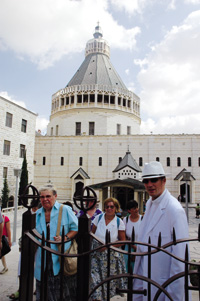From Nazareth to Tiberias, Capharnaum to Mount of Beatitudes, Farzana Contractor traces the footsteps of Christ and comes away over-awed
Nazareth
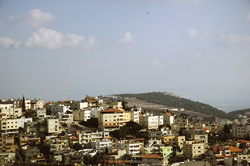 |
| The picturesque town of Nazareth. |
Driving through all of Israel is like being caught in a time warp. The desert sands all around make you wonder how any kind of people managed to survive here. And then you drive into a town and see history unfold itself. It�s like turning the pages of the Bible.
As you drive into Nazareth, a town situated on the slopes of a hill you think about the fact that this is the city where Jesus grew up, studied and lived most of his life. All at once you notice the dominating facto - the Basilica of the Annunciation, an imposing church. It is erected over the grotto where , according to tradition, the Archangel Gabriel announced to Mary that she would be the mother of Christ. It is also believed to be the source of a well where Mary drew water each day.
The large and impressive modern-day church is built above the remains of churches dating back to Crusader and Byzantine times, still visible on the
lower level. The church houses many interesting icons and paintings donated by Christian communities from around the world.
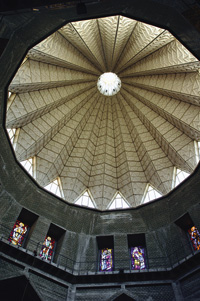 |
| Looking up at the vast dome. |
Although the area had been settled as far back as the Middle Bronze Age, the town where the child Jesus lived was never particularly important. On the contrary, it was despised and its inhabitants were contemptuously called �notzrim� Christians! It was subject to attacks by Romans and later by its aggressive Arab neighbours. In 1099, with the arrival of the Crusaders, Nazareth became a bishopric and the administrative centre of the Galilee. It was repeatedly conquered and lost by the Christian warriors, destroyed finally by the Mamelukes and subsequently abandoned. The Christians resettled into this town only after the Franciscans returned in the 17th century.
Nazareth in Arabic and Hebrew means �guardian�. The population of Nazareth today is extremely varied. Muslims, Arabs and Jews make up two-thirds of the town�s inhabitants with the balance comprising of Christian Arabs, Catholic Greeks, Greek Orthodox, Roman Catholics, Maronite Christians and other smaller groups, all of whom have their places of worship.
A stroll through Nazareth reveals a study in contrasting sights and flavours. Some 100 impressive stately homes from the period of Turkish rule, known as the Old City Mansions, impart an air of grandeur to the city which complements the importance of the churches. Courtyards and lovingly-tended gardens provide islands of tranquility amidst the everyday bustle.
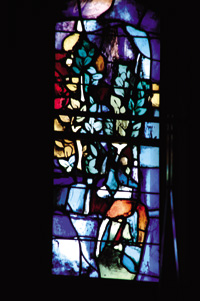 |
| The beautiful stained glass of the church. |
Nearby, the �souk�, the newly refurbished open-air market which serves as the main shopping center for the residents, also promises a cornucopia of delights to the visitor. Not only does the wonderful aroma of coffee perfumed with cardamom fill the air, but one is likely to have it proffered in the classic style of Middle-Eastern hospitality, while perusing a selection of the handicrafts of Nazareth�s artisans. Here is the opportunity to purchase arts and crafts at the source: hand-beaten and engraved copper articles, Christian artifacts and souvenirs, and even traditional icons hand-painted by the Sisters of the Annunciation.
And Nazareth provides sustenance not only for the spirit, but also delicacies for the tummy. The city is reputed for its superior Middle-Eastern restaurants, which serve succulent grilled meats and a profusion of fresh, crisp and savory vegetables and salads, enjoyed to the last morsel when scooped up with freshly baked Arab bread.
The most famous restaurant of Nazareth where one must eat a meal is Diana, with its lovely mezze dishes.
Tiberias
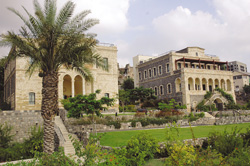 |
| The Scots Hotel at Tiberias. |
Tiberias is a pretty town on the Sea of Galilee. In fact, it�s the only town on its shores. The most popular holiday destination in Israel, Tiberias is an ideal place from which to enjoy the surrounding beauty spots and holy sites.
 |
| The main street of Tiberias. |
Tiberias was founded around 20 AD by Herod the Great�s son, Herod Antipass on the ruins of the ancient town of Rakat, which was destined to become one of the most important centres of Jewish learning and culture, after the destruction of the Temple. The Jerusalem Talmud was largely completed here in the fourth century and vowel symbols were added to the Hebrew alphabet. After having been destroyed more than once by earthquakes, the modern city was rebuilt two kilometers north of the remains of the Roman Tiberias where the thermal springs and spas are present today.
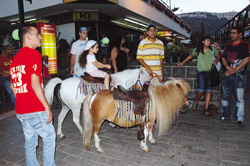 |
| Downtown Tiberias. |
On the south-western shore on the Sea of Galilee, Tiberias is a small and easy place to get to know. There are three basic sections: the Old City, not like the walled city of Jerusalem, but an incongruous mix of styles, and which is the all-important downtown, right by the lakeside; the residential Qiryat Shemuel up the hill and Beit Ma�on, atop the hill from where you get the best views of Tiberias.
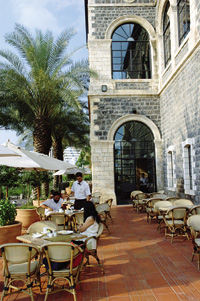 |
| Breakfast at the Scot�s Hotel. |
The nicest place to stay is The Scots Hotel owned and managed by the Church of Scotland, it is set in an extensive garden, with both historic and modern rooms. Situated right on the shore of the Galilee, it even offers views of the Golan Heights. The kitchen is really well stocked, the place serves an amazing buffet breakfast spread.
Capharnaum
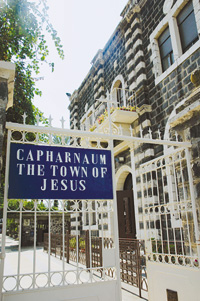 |
| Capharnaum the town of Jesus |
After leaving Tiberias in the early morning I went to Capharnaum located on the northern shore of the Sea of Galilee near the Via Maris route to Syria. It�s a place where Jesus Christ went to live after he left Nazareth and where he preached his first sermon. He chose the town of Caphernaum as the center for his ministry in Galilee.
According to the Gospel of Matthew (4:12) Jesus moved to Caphernaum from Nazareth most likely because Nazareth was a tiny obscure village while Capharnaum was a relatively large town with a population of 15,000 people. It was located on a important road from Beth Shan to Damascus and yet was far enough from official centers like Tiberias and Jerusalem and Jesus was not likely to draw attention to himself too quickly.
 |
| A church over the foundation of the house of Simon Peter. |
Looking around the ruins today, you feel even the stones speak eloquently. Evidence of the ancient town�s splendour can be seen in the old synagogue. For years Franciscan archeologists have excavated and studied the town of Capharnaum. Two sites, especially, are of major interest: the old Jewish Synagogue and the house of Simon Peter.
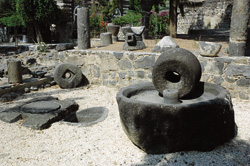 |
| An ancient olive press. |
Synagogues of the first century were built facing Jerusalem. The entrance was in the front. So people would come in then turn around and face the door and Jerusalem. There were stone benches built along the outside walls where the aged or infirm could sit. Everyone else sat on the floor. The scrolls of the law were wheeled in on a portable tabernacle and the services would begin. After the service the portable tabernacle was taken out again. People also used the synagogue as a sort of community center.
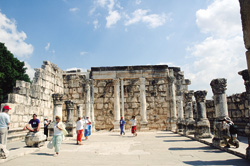 |
| The Old Synagogue. |
Peter�s house was only 30 meters south of the synagogue. It was a large house consisting of several roofed rooms around a spacious courtyard. Three families shared the same house, namely, the families of Peter, his brother Andrew and of Peter�s mother-in-law. This was the standard pattern in the living quarters of Capharnaum. Jesus would have experienced all of the ordinary pleasures and normal tensions of family life in this house; here he would have enjoyed a hot meal at the end of a hard day�s work!
Today, there is a modern church built over the ruins of St. Peter�s house in a very interesting manner. The original foundations are left as they were and the church is built over it, on a cantilever.
Mount of Beatitudes
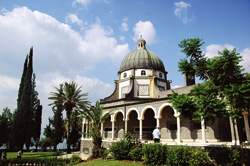 |
| The Chapel on the Mount of Beatitudes. |
From Caphernaum I went to the Mount of Beatitudes. It�s a small mountain, topped by a Catholic chapel built in 1939 by the Franciscan Sisters with the support of the ruler Mussolini. The building which was constructed by the noted architect Antonio Barluzzi is full of numerical symbolism. In front of the church, the symbols on the pavement represent Justice, Prudence, Fortitude, Charity, Faith and Temperaments. Inside the church hangs the cloak from Pope John Paul�s visit in 1964.
The Mount of Beatitudes overlooks the four mile long Pain of Gennesaret, an area famed for its fertility. Jesus was in this area when he healed �the multitudes� and faced pharisaic condemnation for ritual impurity.
Golan
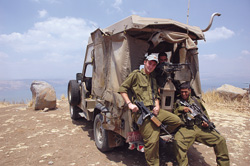 |
| Soldiers patrolling the Golan heights are friendly and warm.
|
Driving to the Golan from Mount of Beatitudes was for me a beautiful experience. This geographic region in the north-east of Israel touches borders with Lebanon, Jordan and Syria. It is a hilly range and the cliffs surrounding the Sea of Galilee provide the most breathtaking view.
The Golan is one of the least visited regions of Israel but when you do visit it you see that it has a beautiful and serene landscape. For nature lovers the Golan has much to offer. In its untamed land, you�ll find flora and fauna from different habitats come together in a unique and natural setting. There are wolves and gazelles around.
For history buffs this region has many prehistoric sites and megalithic edifices, Hellenistic towns, Roman fortresses and Crusader castles standing guard over the roads and ancient highways. For the pilgrim, the Golan is a place where Jesus sought his last moments of peace before embarking on his final journey to Jerusalem.
Over the past few years a range of attractive accommodations have opened on the Golan, from rustic bed-and-breakfast facilities to exclusive guest house hotels. It might well be worth for those going to Israel to include this region in their itineraries. And if you do remember, there are many vineyards in the region too.
PHOTOGRAPHS BY FARZANA CONTRACTOR





